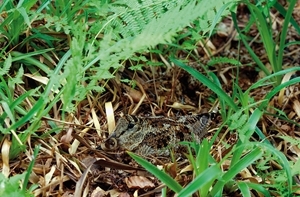 In a 2002 review of the population status of birds in the UK, the woodcock was 'amber-listed' as a bird of conservation concern because of an apparent long-term decline in breeding numbers. However these data, and all those that precede it, were generated from incidental sightings of woodcock during the course of general bird surveys, rather than counts from surveys specific to woodcock. Records from our National Gamebag Census suggested no decline in the numbers of woodcock wintering in Britain, but the vast majority of woodcock shot here are migrant birds from Scandinavia and Russia and hence a problem within our resident breeding population would not be evident in our data.
In a 2002 review of the population status of birds in the UK, the woodcock was 'amber-listed' as a bird of conservation concern because of an apparent long-term decline in breeding numbers. However these data, and all those that precede it, were generated from incidental sightings of woodcock during the course of general bird surveys, rather than counts from surveys specific to woodcock. Records from our National Gamebag Census suggested no decline in the numbers of woodcock wintering in Britain, but the vast majority of woodcock shot here are migrant birds from Scandinavia and Russia and hence a problem within our resident breeding population would not be evident in our data.
Using the number of woodcock sightings on general bird surveys as means of assessing total abundance does not provide the most accurate estimates of population. This is because detection rates are very low; due in part to the woodcock’s cryptic camouflage and secretive nature, as well as the fact that they are most active at dawn and dusk. It became clear that an alternative method was required that was specifically designed to target woodcock.
As a result, GWCT, in conjunction with the British Trust for Ornithology (BTO), launched a nationwide survey of woodcock. The survey involved volunteer observers making three counts of roding woodcock passes in randomly-selected woods that were stratified by 11 regions and four wood size classes. For more information on how these observations are used to calculate population estimates see the page on survey methodology.
The breeding population size, before our 2003 survey, had been estimated at 5,000-12,500 ‘pairs’, based upon sightings made during the course of general bird surveys. We were able to revise this total to an estimated 78,000 ‘pairs’ (95% confidence interval 62,000-96,000), using data obtained from roding count surveys.
In the 2003 survey, we found that woodcock presence varied between regions and wood size classes, with higher occurrence in larger woods. Breeding woodcock were more widely distributed in Scotland and northern England than in southern England and Wales. Weighting by the availability of one-kilometre squares within each region-wood size class gave a national estimate of 35% presence in squares containing at least 10 hectares of woodland. Average woodcock density in occupied woods was 2.76 males per 100 hectares, but there was large regional variation, ranging from 0.87 males per 100 hectares in Wales to 4.10 males per 100 hectares in East Anglia. Perhaps not surprisingly given that we employed a dedicated survey method, our estimate of the national woodcock is far higher than the general bird survey estimate. Our survey showed that Scotland (39,000 males, 95% confidence interval 24,000-57,000) and England (37,000 males, 95% confidence interval 30,000-44,000) support similar numbers of woodcock, with only 2,000 males (95% confidence interval 1,000-3,000) in Wales.
To determine the trend in breeding woodcock numbers we are continuing annual roding counts at about 40 sites with the help of a group of enthusiastic volunteers. We also plan to repeat the national survey at ten-year intervals and the first of these follow-up surveys was conducted in 2013.